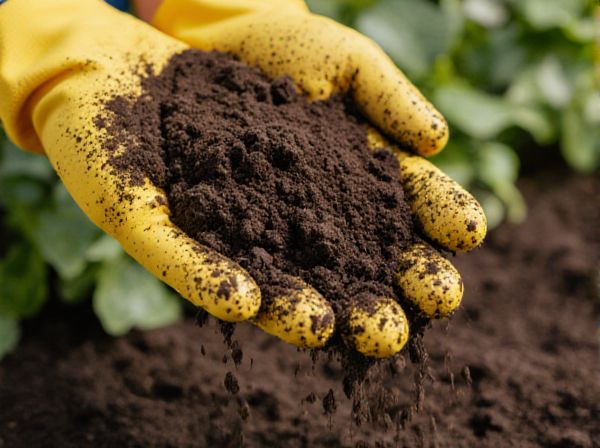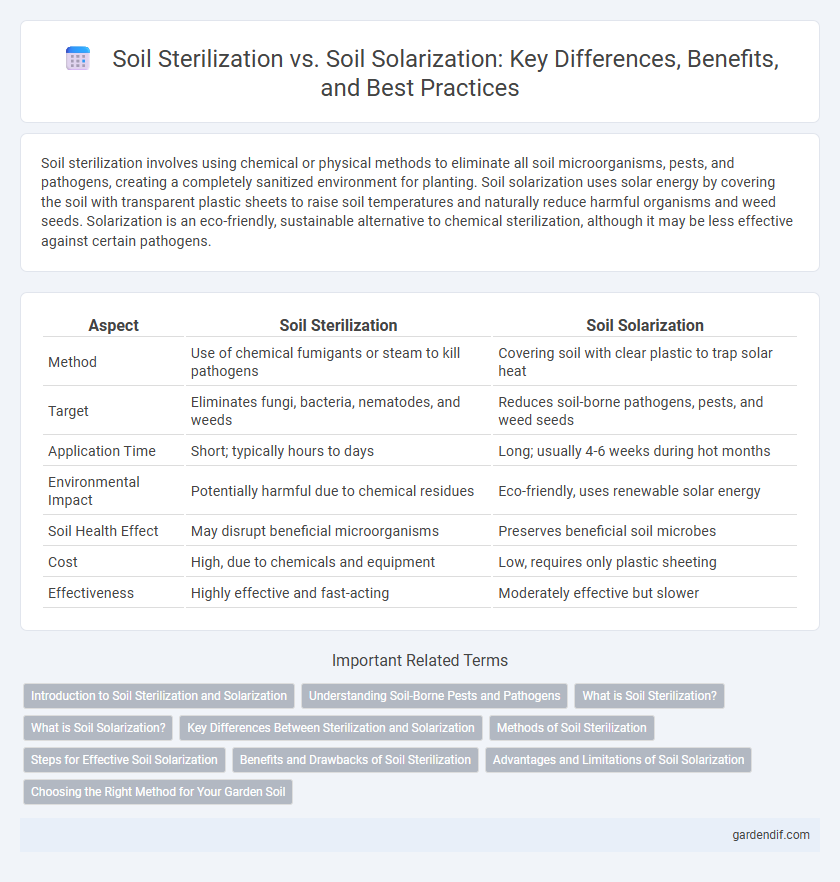
Soil sterilization vs Soil solarization Illustration
Soil sterilization involves using chemical or physical methods to eliminate all soil microorganisms, pests, and pathogens, creating a completely sanitized environment for planting. Soil solarization uses solar energy by covering the soil with transparent plastic sheets to raise soil temperatures and naturally reduce harmful organisms and weed seeds. Solarization is an eco-friendly, sustainable alternative to chemical sterilization, although it may be less effective against certain pathogens.
Table of Comparison
| Aspect | Soil Sterilization | Soil Solarization |
|---|---|---|
| Method | Use of chemical fumigants or steam to kill pathogens | Covering soil with clear plastic to trap solar heat |
| Target | Eliminates fungi, bacteria, nematodes, and weeds | Reduces soil-borne pathogens, pests, and weed seeds |
| Application Time | Short; typically hours to days | Long; usually 4-6 weeks during hot months |
| Environmental Impact | Potentially harmful due to chemical residues | Eco-friendly, uses renewable solar energy |
| Soil Health Effect | May disrupt beneficial microorganisms | Preserves beneficial soil microbes |
| Cost | High, due to chemicals and equipment | Low, requires only plastic sheeting |
| Effectiveness | Highly effective and fast-acting | Moderately effective but slower |
Introduction to Soil Sterilization and Solarization
Soil sterilization involves using chemical or physical methods to eliminate pathogens, pests, and weed seeds, ensuring a clean growing medium. Soil solarization harnesses solar energy by covering moist soil with clear plastic to trap heat, raising temperatures to levels that suppress harmful organisms naturally. Both techniques improve soil health but differ in approach, cost, and environmental impact.
Understanding Soil-Borne Pests and Pathogens
Soil sterilization eliminates soil-borne pests and pathogens through chemical or physical methods, providing immediate disinfection but potentially disrupting beneficial microorganisms. In contrast, soil solarization uses solar heat to naturally reduce pest populations and pathogens by raising soil temperatures, promoting a safer and eco-friendly approach. Understanding the specific pest and pathogen types, such as nematodes, fungi, and bacteria, is crucial for selecting the most effective soil treatment method.
What is Soil Sterilization?
Soil sterilization is a process that eliminates all living organisms in the soil, including pathogens, weeds, and beneficial microbes, using chemical or physical methods such as fumigants, steam, or heat treatment. This technique is employed to create a sterile environment for sensitive crops, preventing diseases and pest infestations that can hinder plant growth. Unlike soil solarization, which uses natural solar heat to reduce pests and pathogens gradually, sterilization provides immediate and complete microbial eradication but may also disrupt soil ecology.
What is Soil Solarization?
Soil solarization is an eco-friendly agricultural technique that uses solar energy to eliminate soil-borne pathogens, weeds, and pests by covering moist soil with transparent polyethylene sheets for several weeks during high-temperature periods. This method harnesses solar heat to raise soil temperatures to levels lethal for harmful microorganisms, improving soil health and crop yields without chemical use. Soil solarization is especially effective in warm climates and is a sustainable alternative to chemical soil sterilization.
Key Differences Between Sterilization and Solarization
Soil sterilization uses chemical or heat treatments to eliminate all microorganisms, including beneficial ones, resulting in a completely sterile environment that can impact soil health negatively. Soil solarization employs transparent plastic sheets to trap solar energy, raising soil temperature to 45-60degC, selectively targeting pathogens and weed seeds while preserving beneficial microbes. Solarization is eco-friendly and cost-effective, whereas sterilization often requires expensive inputs and poses risks of chemical residues or soil structure disruption.
Methods of Soil Sterilization
Soil sterilization involves using chemical fumigants like methyl bromide or chloropicrin, steam treatment, and hot water application to eradicate soil-borne pathogens, weeds, and pests effectively. These methods provide rapid and thorough disinfection but may pose environmental and health risks due to chemical residues. In contrast, soil solarization relies on trapping solar energy under transparent plastic covers to raise soil temperatures, offering an eco-friendly alternative without chemical use but requiring longer treatment periods.
Steps for Effective Soil Solarization
Effective soil solarization involves thoroughly moistening the soil, then covering it with clear polyethylene plastic for 4 to 6 weeks during the hottest part of the year to trap solar energy and raise soil temperatures. Maintaining a tight seal around the plastic edges ensures maximum heat retention and effective pathogen elimination. Properly prepared soil with optimal moisture and temperature conditions suppresses weeds, pests, and soil-borne diseases naturally without chemicals.
Benefits and Drawbacks of Soil Sterilization
Soil sterilization effectively eliminates pathogens, weeds, and pests through chemical or heat treatments, enhancing crop yield and preventing disease outbreaks. However, it poses risks such as harmful chemical residues, disruption of beneficial soil microorganisms, and high operational costs. While it provides rapid and thorough soil disinfection, the potential environmental impact and loss of soil biodiversity remain significant drawbacks.
Advantages and Limitations of Soil Solarization
Soil solarization uses solar energy to heat the soil, effectively reducing soil-borne pathogens, pests, and weeds without chemical use, making it environmentally friendly and enhancing soil nutrient availability. Its advantages include being a non-toxic method that improves crop yields and suppresses nematodes and fungi, with minimal impact on beneficial soil organisms. Limitations involve dependency on high ambient temperatures and prolonged duration, typically requiring 4-8 weeks of clear, sunny weather, which restricts its practicality in cooler or less sunny climates.
Choosing the Right Method for Your Garden Soil
Soil sterilization uses chemical or heat treatments to eliminate pathogens, offering quick and thorough disinfection but potentially disrupting beneficial microorganisms. Soil solarization relies on solar energy by covering moist soil with clear plastic, raising temperatures to suppress pests, weed seeds, and diseases while preserving soil ecology. Gardeners should evaluate the scale, environmental impact, and soil health needs to select between the rapid efficacy of sterilization and the eco-friendly benefits of solarization.
Soil sterilization vs Soil solarization Infographic

 gardendif.com
gardendif.com